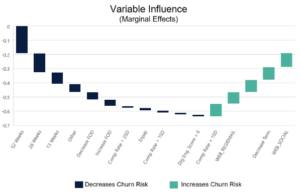By Nathan Hart, Manager of Consulting Services
Summary
- Acquiring new subscribers can be a costly endeavor, making ongoing, proactive churn management a crucial component of a robust subscription revenue model.
- Not all churn is created equal. Churn can be considered Voluntary (i.e., Subscriber actively cancels their subscription) or Involuntary (i.e., The subscriber’s credit card expires, causing a transaction failure). Publishers should monitor both sources of churn and apply tailored strategies and solutions to improve overall retention.
- The majority of voluntary churn is not due to price. Understanding the drivers of subscriber churn is the key to effective churn management.
- Proactive, data-driven, and personalized strategies are key to reducing churn effectively.
The Importance of Churn Management
It is widely understood that acquiring a customer is much costlier than retaining one. When a subscriber cancels their subscription, revenue drops due to the lost recurring revenue and the expense of acquiring a new customer. Furthermore, former subscribers tend to return on promotional offers, so it may take years for them to reach their previous payment level, if they do so at all.
Not all Churn is Created Equal
Effectively managing churn requires an understanding of the diverse types of subscriber churn. When a subscriber actively cancels their subscription, it is considered Voluntary churn. In contrast, Involuntary or Passive churn occurs when the subscription is terminated without the subscriber’s action, such as when a credit card expiration leads to payment failure.
Oftentimes publishers assume that subscription price increases are the main driver of voluntary churn, but this is usually not the case. Publishers will always be challenged with some level of “Organic” churn, loss that is not attributable to any shock-inducing external influence like a price increase. Organic churn ebbs and flows, even with no pricing action and is influenced by the current acquisition strategy, seasonality, operational changes (e.g., delivery day reductions or mail conversions), and macroeconomic conditions. When these factors cause churn to spike, publishers often default to more conservative pricing strategies in hopes of bringing churn back down. However, this is where differentiating price-related churn from other types of churn becomes critical for informed, data-driven decision-making.
In late 2022, Mather Economics conducted a study of over 200 news media publications, assessing how trends in pricing-related churn coincided with organic churn during one of the largest macroeconomic shocks in modern history, and the results were fascinating. Mather found that amidst rising inflation, subscriber pricing sensitivity (or price elasticity) declined across print and digital subscription products. This means that subscribers were in fact less likely to cancel if their price were increased relative to normal circumstances, despite the underwhelming macroeconomic conditions and higher levels of organic churn.
Preempt Churn to Lower Churn
Drawing on decades of experience modeling subscriber cancellations, Mather Economics has observed that pricing is not the primary driver of churn. There are several other factors that come into play, with the specific set and magnitude of influence varying widely from publisher to publisher. These characteristics include product type, delivery frequency, engagement level, payment method, tenure, complaint history, and more. The table below is an example sourced from a Mather churn model demonstrating how different characteristics influence subscriber churn risk.

Modeling results from a sample publisher reveal that being on a 52-week term lowers a subscriber’s churn risk the most, while starting a subscription from social media platforms (WEB_SOCIAL) increased churn likelihood the most among the variables considered.
By nature, a subscriber’s decision to churn will happen unless proactive action is taken. While large-scale campaigns can be effective in some cases, publishers must be careful not to bombard subscribers with generic and frequent messaging. Robust data-driven and personalized tactics tend to be the most effective when it comes to churn mitigation.
Curious to learn more?
- Read about how a publisher leveraged Mather’s predictive modeling and A/B testing to execute a personalized churn reduction campaign
- Explore how one publisher partnered with Mather to evaluate the impact of specific retention incentives on churn outcomes
Connect with us to discover how Mather Economics can uncover subscriber churn risk and create an effective strategy to boost engagement and protect revenue!

